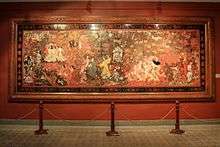Nguyễn Gia Trí
Nguyễn Gia Trí (Chương Mỹ, Hà Tây 1908 - 1993) was a Vietnamese painter.[1] He was best known for his mastery of lacquer painting.[2][3][4] He also drew cartoons on political and social issues, many of them criticising French colonial rule.[5]
Tri studied at the Hanoi College of Fine Arts (École des Beaux-Arts de l’Indochine) from 1932.[5] He worked for the magazines Phong Hóa and Ngày Nay starting from 1932 together with Nhất Linh and other famous writers and painters. He created the cartoon characters Xã Xệ and Bang Bạnh for the magazines and made changes to the character Lý Toét developed by Nhất Linh.[5]

Lacquer painting "Vườn xuân Bắc Trung Nam" in Fine Arts Museum Ho Chi Minh city
Works
Many of his works are in the Vietnam National Museum of Fine Arts, Hanoi.
 Playing in spring, sketch on paper
Playing in spring, sketch on paper
gollark: > aren't you just bad at everythjin gollarkno. you are wrong.
gollark: ... well, this is unhelpful.
gollark: But apparently it takes 500 milliseconds to render a few hundred kilobytes of markdown content, so now I have to figure out how firefox's profiler works.
gollark: When you hover over a link, it automagically™ downloads the associated content using advanced onmouseover technology.
gollark: I've managed to significantly improve minoteaur performance by implementing prefetching.
References
- Smithsonian Institution. (1995). An ocean apart : contemporary Vietnamese art from the United States and Vietnam = Nghìn trùng xa cách : mỹ thuật đương đại Việt Nam ở Hoa Kỳ và ở Việt Nam. Washington, D.C.: Smithsonian Institution. Traveling Exhibition Service. pp. 66–67. ISBN 1570980551.
- Witness Collection - Trần Văn Cẩn "Cẩn is considered one of the pioneering “Four Masters” of Vietnamese modern art, alongside Nguyễn Gia Trí, Nguyễn Tường Lân and Tô Ngọc Vân."
- Culture and Customs of Vietnam Mark W. McLeod, Thi Dieu Nguyen - 2001 Page 104 "Nguyen Gia Tri, his classmate, was among the first to master lacquer painting. At its best, his work combined techniques from the West and the East, using the multiple layers in lacquer painting to convey depth and illusion,"
- Insight Guides - Vietnam 2002 Page 110 "While Nguyen Gia Tri's works continue to generate acclaim for transforming the traditional decorative art form of lacquer to an Art Nouveau style depicting Vietnamese subjects and atmosphere, "
- Lý Trực Dũng (2010). Biếm họa Việt Nam. Hanoi: NXB Mỹ Thuật. p. 34.
This article is issued from Wikipedia. The text is licensed under Creative Commons - Attribution - Sharealike. Additional terms may apply for the media files.